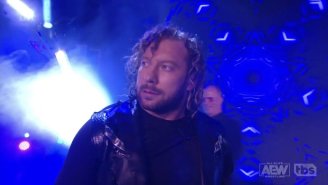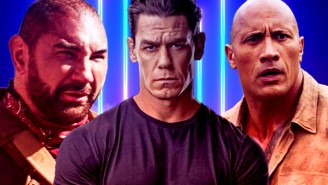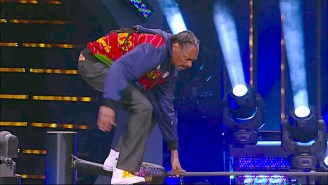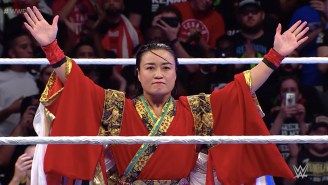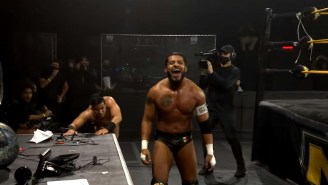Extreme Championship Wrestling was both destined to be great and doomed to fail.
Throughout the mid to late ‘90s, the grungy Northeastern promotion set the tone for a wrestling boom period known as “attitude.” ECW was never acclaimed for its production value, but for its realistic characters and storylines, as well as its loyal and bloodthirsty fans.
At the time of its run, ECW became the third most popular promotion in the country, behind Vince McMahon’s World Wrestling Federation (now-WWE) and Ted Turner’s World Championship Wrestling. The overwhelming violence has often been cited as a reason for ECW’s lack of mainstream appeal. In addition, it consistently received little to no advertising. Running as far as it could with what little it had, it was only a matter of time before ECW would face a heap of financial problems that would culminate in its death.
Too Big To Be Small, Too Small To Be Big
Wrestling promoter Gabe Sapolsky joined ECW in the mid-‘90s and became Paul Heyman’s personal assistant. He was at the forefront of the promotion’s highest of highs, and lowest of lows. “We would see some of the production at TV tapings being cut down,” Sapolsky tells us, remembering the first indicators that ECW was going under. “Once you start seeing that kind of cost-cutting, that was a sign that things were on the decline and that trouble was ahead of us.”
If people looked past its money problems and only saw ECW’s fan support, not many would have guessed things were falling apart. “There were still large crowds, the fans were super into it, the merch was selling a lot… I believe the problem is there just wasn’t enough money to compete with WWE and WCW,” Sapolsky says. “You had a lot of wrestlers who were on big weekly guarantees, and ECW had to give them those guarantees because you had both WWE and WCW taking any piece of available talent they could. It got to the point where the promotion got too big to be small and too small to be big…” It was inevitable that its top talent would want to head for greener pastures in the top two promotions, and that caught up with ECW in the new millennium.
“It just didn’t have the guns to match WWE or WCW, but at the same time was trying to,” Sapolsky explains. “So, the expense level was just above the means. As far as being the number three promotion, that had a following, did a decent rating on TV if I remember… there was one show in Toronto the last year that had like 5,000 people at it. So, the crowds were there, but it just wasn’t enough to cover the amount of expense there was that was mainly due to having to lock up the talent that was going to WWE and WCW at the time. It was just a balloon that kept blowing up.”
January 7, 2001 would be the night ECW held its final pay-per-view event, Guilty as Charged from the Hammerstein Ballroom in New York City. The event was not intended to be its final pay-per-view, but, at this point, ECW’s successful weekly television program had been canceled three months earlier, and it was now a promotion in search of a new network. As was normally the case, whether it had a network or not, only fans who closely followed ECW knew there was a pay-per-view that night.
“The writing was pretty much on the wall at that point,” Sapolsky says. “I remember going up to Sign Guy Dudley, who was a close friend of mine, and saying, ‘Hey, does anybody else realize we’re not on TV anywhere right now?’ To me, that was the number one sign that a new TV deal wasn’t happening and this would be it. I definitely felt like it was the last show. I actually made a point to sit in the crowd and watch it, or watch most of it, because I knew it was kind of like one of the last times, or maybe the last time, I was gonna be able to sit in the stands and watch an ECW show.”
Living Week To Week
The event was headlined by ECW Champion Steve Corino defending his title in a three-way ladder match against Sandman and Justin Credible. Sandman won the match and the title, and immediately lost it in an impromptu match against Rhino, who would be recognized as the promotion’s final champion. Although pay-per-view main events are normally world title matches, Rob Van Dam vs. Jerry Lynn was the closing match of this show. RVD had become ECW’s most popular star in its final years, so it was somewhat fitting that he would end its final PPV. ECW originally scheduled its next pay-per-view, Living Dangerously, for March, but canceled the event the month prior.
Heyman, who was unavailable for comment due to WrestleMania 32 commitments, has previously placed blame squarely on not reaching a new network deal for ECW’s downward spiral that ultimately led to the promotion going out of business. Sapolsky’s story is basically the same, as he tells us that the company needed an investor that would have allowed ECW to sustain the money losses it would have taken to get to the level of the top two promotions, or it needed a network that was firmly behind it and provided sufficient financial backing.
“What you were dealing with at ECW was we were still a mom and pop company. I mean, we were the third largest company and on national TV, but we were still being run out of people’s apartments and homes,” Sapolsky says. “We just never had the backing to get the tools we needed to compete on that level. You can say it would have been nice if we had tons of money to throw into promoting live events, or maybe enough money to sign all the talent leaving us and going to WCW and WWE, and maybe us being able to sign one of their biggest stars. But, really, it all goes back to the network and being backed and having that financial pool to draw from, and we just never did. We were just a company living week to week.”
One of the biggest nails in the coffin of ECW was driven in on March 5, 2001, the night Paul Heyman arrived on WWF television, serving as the new color commentator alongside Jim Ross on Monday Night Raw. After months of denial from its fans, as well as its talent, the creative genius behind ECW had moved on.
“I didn’t know he was gonna be on Raw until he was on it,” Sapolsky said. “Everyone was surprised, and everyone was calling each other trying to figure out what was going on. I did talk to Paul after Raw, which was a phone call I’ll never forget, where he pretty much told me it was over. He had to do what he had to do, and he tried to help out as many people as he could along the way, but it was the only move to make at that point for him.”
And Then There Was One
ECW officially closed its doors on April 4, 2001 after filing for bankruptcy. At the time of its closing, the promotion owed more than $500,000 to at least 40 workers. Notable debts included $150,000 for Rob Van Dam; $100,000 for Tommy Dreamer; $50,480 for Joey Styles; $50,000 for Rhino; $47,275 for Francine Fournier, as well as $48,000 for Shane Douglas, who had actually left ECW two years prior. (One of the more interesting debts brought to light included $587,500 owed to the World Wrestling Federation, which reinforced the notion that Paul Heyman had been involved in a business partnership with Vince McMahon over the course of his promotion’s run. ECW stars had appeared on WWF television and pay-per-view in the past, leading many to believe the WWF was helping ECW stay afloat in exchange for its talent. The debt, however, proves that ECW was actually paying for the exposure.)
April 4 may be the official death date for ECW, but to Sapolsky its fate was sealed a month earlier after his conversation with Heyman. “I kind of moved on,” he remembers. “I know there are people who hadn’t and were still holding out hope something was happening… I don’t remember exactly how I learned it was bankrupt; I probably just read it online or something. But at that point, everything was like a foregone conclusion to me.” Even though Sapolsky had a different deal from the wrestlers involving the programs and was able to sustain himself, it’s been reported that he’s owed in the neighborhood of a thousand dollars from ECW. If there is any money he’s owed, it’s inconsequential and doesn’t bother him at all.
In regard to the ECW talent, jumping ship to the WWF at this time wasn’t so easy, as World Championship Wrestling also bit the dust on March 26, 2001. That was when WCW aired its final Monday Night Nitro, where, in storyline, the WWF’s Shane McMahon purchased the company. In actuality, Vince McMahon bought the floundering WCW for a minuscule amount of money compared to what it was once worth. With the WWF’s acquisition of WCW, and later the bankrupt ECW on April 11, there went from being three major promotions in the U.S. to one in just a matter of weeks. Not only was the entire ECW roster now out of a job, but so was the talent pool at WCW, and the WWF was now the only place for all of them to go.
“It was really a negative time for wrestling because all the competition was defeated, and WWE was king,” Sapolsky says. “I believe the lack of competition hurt the business, and the reason why I believe the more healthy companies there are, the better it is for wrestling, is that when the other companies go out of business, the fans don’t all necessarily go start watching the one company that’s remaining. Instead, the fans all just disappear and stop watching wrestling altogether. So, what really kind of led to the business failing was you had WCW fans and ECW fans that didn’t really just jump on board with WWE, and they just stopped watching. It was definitely a dark day, no doubt.”
If the TV ratings are any indication, there was some initial interest: The edition of Raw in which the WWF bought WCW scored a 4.7 rating, and had a massive bump the following week with a 5.65 (to be fair, this was the show that followed WrestleMania X-Seven and top star Stone Cold Steve Austin’s heel turn, so the increase may not have been entirely because the WCW audience switched over). The numbers, however, would pretty much decline back down to the low to mid-4s over the following two months. A select group of ECW stars made their WWF debuts around this time, including Rhino, Justin Credible, and Jerry Lynn, but there’s not much evidence that their appearances on WWF television brought over a significant amount of ECW fans. That could largely be because none of them were necessarily featured as prominent talent, and were mostly lost in the shuffle of the number one promotion.
Rob Van Dam and Tommy Dreamer joined their ECW brethren in the WWF on July 9, 2001, and they would team up in a storyline with WCW as part of the infamous “Invasion” angle, in which they would gang up on the WWF. The only thing that needs to be remembered about it is that it’s considered by many to be the most poorly-handled and detrimental wrestling angle in history.
Sapolsky never made plans to reunite with his mentor Heyman in the WWF once ECW closed, and committed to other plans instead. But when it comes to the death of his beloved hardcore home, the regrets are there.
“I wish I had done more to promote, and anything that I could, really,” he admits. “You just have a feeling when something you love that much just disappears, and you think, ‘Maybe I could have handed out more flyers, or maybe I could have done more online.’ It takes a while to get through that, and once you do, you kind of realize there was nothing else I could have done. But you definitely have that feeling, even being on the smallest level, of what more could I have done to bring awareness to the ECW brand, or get more eyeballs on the product, or get the fans more excited about it. You do go through that phase, which I definitely went through. I thought about that for a while, but then you kind of get to the point where, when the details come out, and you realize there was nothing we could have done.”

